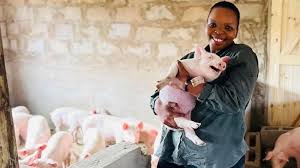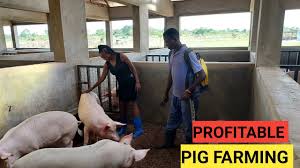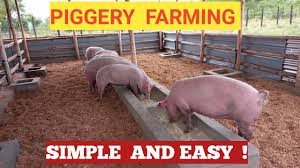How to Start and Run a Successful Piggery Farming Operation
Piggery farming is a highly profitable agricultural venture that, when properly planned and managed, can yield significant returns. Pigs are known for their fast growth rate, high reproduction potential, and efficient feed-to-meat conversion ratio. However, to succeed in the pig farming business, you need to have the right knowledge, a well-structured business plan, and an effective strategy for attracting customers. Here’s a step-by-step guide to help you start and run a successful piggery farming operation.
Step 1: Conduct Thorough Market Research
Before starting your piggery business, conduct in-depth research on the market demand, competition, and pricing strategies in your area. Understanding the market will help you make informed decisions regarding the type of pig breed to rear, the scale of production, and potential buyers.
Key Factors to Consider in Market Research:
- Demand for pork and pork products in your target region.
- Competitors in the pig farming industry and their business models.
- Preferred pig breeds in the market.
- Selling prices of live pigs and pork meat.
- Availability and cost of pig feed and veterinary services.
Step 2: Create a Comprehensive Business Plan
A well-structured business plan is the foundation of a successful piggery farming operation. A business plan will outline your goals, financial projections, marketing strategies, and operational plan. If you need assistance in drafting a professional and investor-ready business plan, hiring an experienced business plan writer is advisable.
Where to Find a Professional Business Plan Writer:
- Business Consulting Firms: Many firms specialize in agribusiness plans and can provide expert help.
- Agricultural Extension Offices: Some government agencies offer business planning support to farmers.
- Online Business Planning Services: Some companies specialize in writing investor-ready business plans tailored to your industry.
A professional business plan writer will help you create a plan that includes financial forecasts, risk assessments, and strategies for sustainable growth.
Step 3: Choose the Right Location for Your Piggery
Selecting the right farm location is critical for a successful piggery business. The location should be spacious, well-ventilated, and have access to clean water and electricity.
Key Considerations for a Suitable Location:
- Proximity to Market: Choose a location near your target customers to reduce transportation costs.
- Availability of Water and Electricity: Pigs require plenty of clean water for drinking and hygiene.
- Biosecurity Measures: The farm should be located far from residential areas to minimize disease transmission.
- Space for Expansion: Ensure there is enough room for future growth and additional pig pens.
Step 4: Select the Best Pig Breeds
Choosing the right breed of pigs is essential for maximizing productivity and profitability. The most popular breeds for commercial pig farming include:
- Landrace: Known for high fertility rates and excellent growth performance.
- Duroc: Resistant to diseases and has a high feed-to-meat conversion ratio.
- Large White: Commonly used for commercial pig farming due to its rapid growth rate.
- Berkshire: Produces high-quality pork and is suitable for premium markets.
When selecting pig breeds, consider their adaptability to your local climate and market preferences.
Step 5: Construct Proper Housing and Facilities
Pigs require well-constructed housing to ensure their health, growth, and productivity. The housing should be designed to provide comfort and protection from extreme weather conditions.
Essential Features of a Piggery Housing:
- Proper ventilation to prevent respiratory diseases.
- Separate pens for different age groups (piglets, growers, and breeders).
- Slatted floors or proper drainage systems to maintain hygiene.
- Secure fencing to protect pigs from predators and theft.
Step 6: Implement an Effective Feeding Program
Proper feeding is crucial for pig growth and overall farm profitability. The diet should be balanced and contain essential nutrients such as protein, carbohydrates, vitamins, and minerals.
Types of Pig Feed:
- Starter Feed (Piglets): Rich in protein to promote early growth.
- Grower Feed: Designed for pigs in the growth phase to ensure weight gain.
- Finisher Feed: Given to pigs before slaughter to improve meat quality.
- Supplementary Feeds: Agricultural by-products like maize bran, wheat, and soybean meal can be used to reduce feeding costs.
Ensure that your pigs always have access to clean drinking water to maintain their health.
Step 7: Maintain Proper Health and Biosecurity Measures
Pigs are susceptible to various diseases, which can cause significant financial losses if not managed properly. Implementing strict biosecurity measures will help prevent outbreaks.
Key Biosecurity Measures:
- Vaccinate pigs against common diseases such as swine fever and pneumonia.
- Regularly disinfect pig pens and feeding equipment.
- Limit farm access to authorized personnel only.
- Isolate sick pigs to prevent the spread of diseases.
Working closely with a veterinarian will ensure the health and productivity of your pigs.
Step 8: Develop a Strong Marketing and Sales Strategy
To succeed in pig farming, you need a well-defined marketing strategy to attract customers and maximize sales.
How to Attract Customers Easily:
- Leverage Social Media: Use Facebook, Instagram, and WhatsApp to market your pigs and pork products.
- Network with Local Butchers and Restaurants: Build relationships with butchers, hotels, and restaurants that buy pork in bulk.
- Attend Agricultural Trade Shows: Participate in trade fairs to showcase your pigs and connect with potential buyers.
- Set Up a Farm Website: A website with professional images and customer testimonials can boost your credibility.
- Partner with Supermarkets: Supply supermarkets and grocery stores that sell fresh pork.
- Offer Home Delivery Services: Providing doorstep delivery can attract busy customers who prefer convenience.
By implementing a combination of online and offline marketing strategies, you can create a strong customer base and increase sales.
Step 9: Financial Planning and Cost Management
Managing finances effectively is crucial for sustaining and growing your pig farming business.
Key Financial Considerations:
- Startup Costs: Budget for land, housing, pig breeds, feed, veterinary care, and labor.
- Operational Costs: Track expenses such as feed, water, electricity, and medical treatments.
- Profitability Analysis: Calculate the cost of rearing pigs versus the selling price to determine profit margins.
- Funding Options: Consider agricultural loans, grants, or investor partnerships to scale your business.
Keeping accurate financial records will help you make informed business decisions and attract potential investors.
Conclusion
Starting and running a successful piggery farming operation requires careful planning, market research, and efficient management. By selecting the right pig breeds, implementing biosecurity measures, developing a strong marketing strategy, and managing finances effectively, you can establish a profitable pig farming business.
If you need a professional business plan writer to guide you in structuring your piggery business, consider hiring an expert from business consulting firms, freelance platforms, or online business planning services. With the right strategy and dedication, you can build a sustainable and thriving piggery farming operation.
Would you like assistance in writing a custom business plan for your pig farming venture? Let me know how I can help! 🚀



